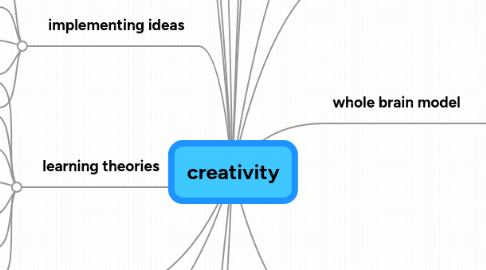creativity
von pinky xin


1. innovation
1.1. disruptive
1.2. rodical
1.3. incrimental
2. knowledge storage
2.1. cognitive
2.1.1. process
2.1.2. behaviour
2.1.3. pattern
2.1.4. control thought
3. time management
3.1. computer
3.2. New node
4. blocks
4.1. organisational blocks
4.2. personal blocks
4.3. mindset
5. information processing
5.1. long term memory
5.2. short term memory
5.3. sensory memory
5.4. external stimulus
5.5. response
6. problem solving
6.1. objective finding
6.2. fact finding
6.3. problem finding
6.4. idea finding
6.5. solution finding
6.6. acceptance finding
7. evaluation
7.1. major consideration
7.2. essential factors
7.3. fall-back position
7.4. testability
7.5. risk
7.6. final decision
8. implementing ideas
8.1. change
8.2. communication
8.3. practice
8.4. analysis
8.5. selling
9. learning theories
9.1. sensory stimulation
9.2. reinforcement
9.3. holistic
9.4. facilitation
9.5. experiential
9.6. action
9.7. adult
10. six thinking hats
10.1. different thinking style
11. lateral thinking
11.1. awareness
11.2. alternative
11.3. provocative
11.4. brainstorming
11.4.1. random input
11.4.2. reframing
11.4.3. professions approach
11.4.4. provocation
11.4.5. SCAMPER system
12. morphological
12.1. checklist
12.2. attribute listing
12.3. morphological analysis
12.4. force fitting triggers
12.5. Heuristic ideation technique
12.6. component detailing
12.7. sequence-attribute
12.8. modification matrix
13. taking risk
13.1. confident
13.2. skill
14. Characteristics
14.1. social
14.2. confident
14.3. leadership
14.4. creative
14.5. adaptable
14.6. adventurous
14.7. logical
15. whole brain model
15.1. left brain
15.1.1. logic
15.1.2. sequential
15.1.3. incremental
15.1.4. reality
15.1.5. attention to detail
15.2. right brain
15.2.1. intuitive
15.2.2. random
15.2.3. holistic
15.2.4. fantasy
15.2.5. thin outside the square
